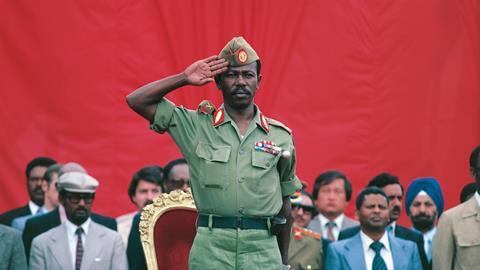First comprehensive account of atrocity crime
The Oxford Handbook on Atrocity Crimes
Edited by Barbora Holá, Hollie Nyseth Nzitatira and Maartje Weerdesteijn
£115, Oxford University Press
★★★★✩
Christmas Eve 2002. I’m on the Great Barrier Reef and my assistant solicitor phones to say that I’m on the front page of the Guardian under the headline ‘Ethiopia faces £330m claim’. This refers to a claim I was bringing on behalf of a Greek client whose property had been expropriated by the previous military government of Ethiopia which was reported to have murdered up to 1.5 million people during its rule. The regime also confiscated all private property (see the headline of the 26 July 1975 Ethiopian Herald, inset).
The war in Ukraine has sadly highlighted other instances of war and atrocity crimes. Article 8 of the Rome Statute of the International Criminal Court defines war crimes as: ‘Other serious violations of the laws and customs applicable to international armed conflict within the established framework of international law.’
A war crime can be a single criminal act. It includes crimes against humanity and acts of genocide. ‘Crimes against humanity’ did not exist or at least were not enshrined in international law until Hersch Lauterpacht introduced the concept at the Nuremberg trials after the second world war. Raphael Lemkin submitted a paper to the League of Nations which introduced the legal concept of genocide. This was subsequently adopted in 1948 by the UN General Assembly which passed the Convention on the Prevention and Punishment of the Crime of Genocide. Atrocity crimes are an overarching phenomenon including crimes of genocide, crimes against humanity, and war crimes. It is large-scale criminality. Atrocity crimes are not isolated incidents and they often occur during armed conflicts.
The Oxford Handbook on Atrocity Crimes has contributions from numerous commentators and includes a review of crimes of genocide, crimes against humanity and war crimes. There are also case studies including atrocity crimes in Ethiopia, Angola, Columbia, Indonesia, Guatemala and Iraq.
The book is a substantial work (almost 1,000 pages) and is divided into six parts. It begins with a general overview of the legal foundations of atrocity crime and then turns to methodologies. These include atrocity crimes, etiology and causes, actors in such crimes, harm and victims, reactions to atrocity crimes and selected case studies.
Chapter 35 focuses on crimes against humanity in Ethiopia. Following the fall of Haile Selassie a Provisional Military Administration Council of Ethiopia was established which was known as the ‘Dergue’. Haile Mariam Mengistu (pictured above) was its leader. The Dergue eliminated all imperial state structures and murdered their officials.
Mengistu initiated a purge known as the Red Terror which gave carte blanche to security forces and intelligence services to liquidate ‘counter-revolutionaries’. It started with targeted arrests, torture, and murder of dissidents, as well as mass executions by firing squad. House-to-house searches occurred daily and massacres were carried out publicly with corpses displayed in the streets. It is estimated that in one eight-month period 3,000-4,000 people were murdered in Addis Ababa alone. By the end of 1978 about 400,000 dissidents were in prison. The Red Terror was later classified as an act of genocide.
Throughout the 1980s the Dergue created conditions for famine and controlled aid. It was not only drought or climate change that caused mass starvation between 1983-1985. It was the state’s policy to use hunger as a weapon of war resulting in the death of 600,000 Ethiopians. This was a crime against humanity. While Bob Geldof and others admirably raised millions of pounds through Live Aid, it was widely reported that Mengistu’s government had placed one of the largest single orders for champagne that year in the world. It is estimated that the civilian death toll during the Dergue’s reign reached 1.5 million.
Mengistu fled to Zimbabwe when the Dergue fell and was protected by Robert Mugabe. Mengistu remains at liberty in Zimbabwe. Although there have been calls for his extradition to Ethiopia to face war crimes allegations, no such extradition has been effected and no steps have been taken to prosecute Mengistu in Zimbabwe.
In 1991 the Ethiopian People’s Revolutionary Democratic Front came to power by force. Further atrocities and violence continued until the installation of prime minister Abiy Ahmed’s new government in 2018. Sadly, famine is currently being deployed by Abiy’s government as a weapon in the ongoing civil war between Ethiopia and the province of Tigray. In October 2021 an Economist headline read ‘Ethiopia is deliberately starving its own citizens’.
Part V of the book provides an overview of the reactions to atrocities focusing on transitional justice, criminal accountability, reparations and apologies. Chapter 26 focuses on international criminal courts and tribunals as the primary mechanism to address atrocity crimes at the international level. However, there are serious difficulties that impede the criminal prosecution of mass atrocities. Chapter 27 focuses on investigations and prosecutions of sexual violence of atrocity crimes.
Jeremy Julian Sarkin in Chapter 8 examines the inter-relationship between amnesties and truth commissions. He focuses on the South African Truth and Reconciliation Commission and also the role of amnesties in Grenada, Indonesia, the Democratic Republic of the Congo, Nepal, East Timor, Liberia, Kenya and South Korea. In Chapter 30 Stephanie Wolfe examines the concept of reparations and apologies.
The book ends with the powerful words of a Yezidi monk in Lalish, Iraq: ‘There are many beautiful flowers in this world. We are but one colour. Don’t let us disappear.’
Stephen D Sutton is principal of Suttons Solicitors and International Lawyers, London W1
































No comments yet